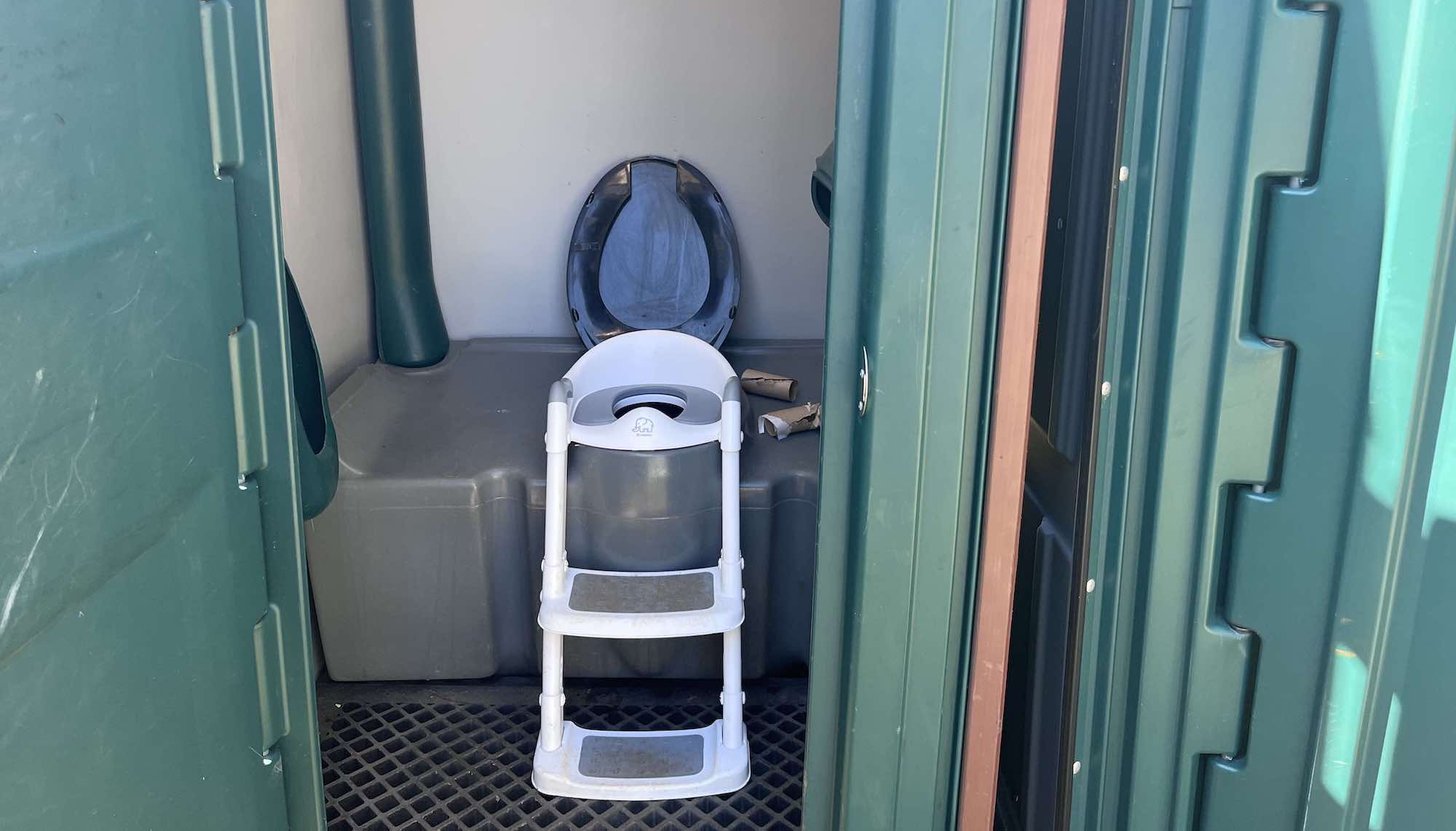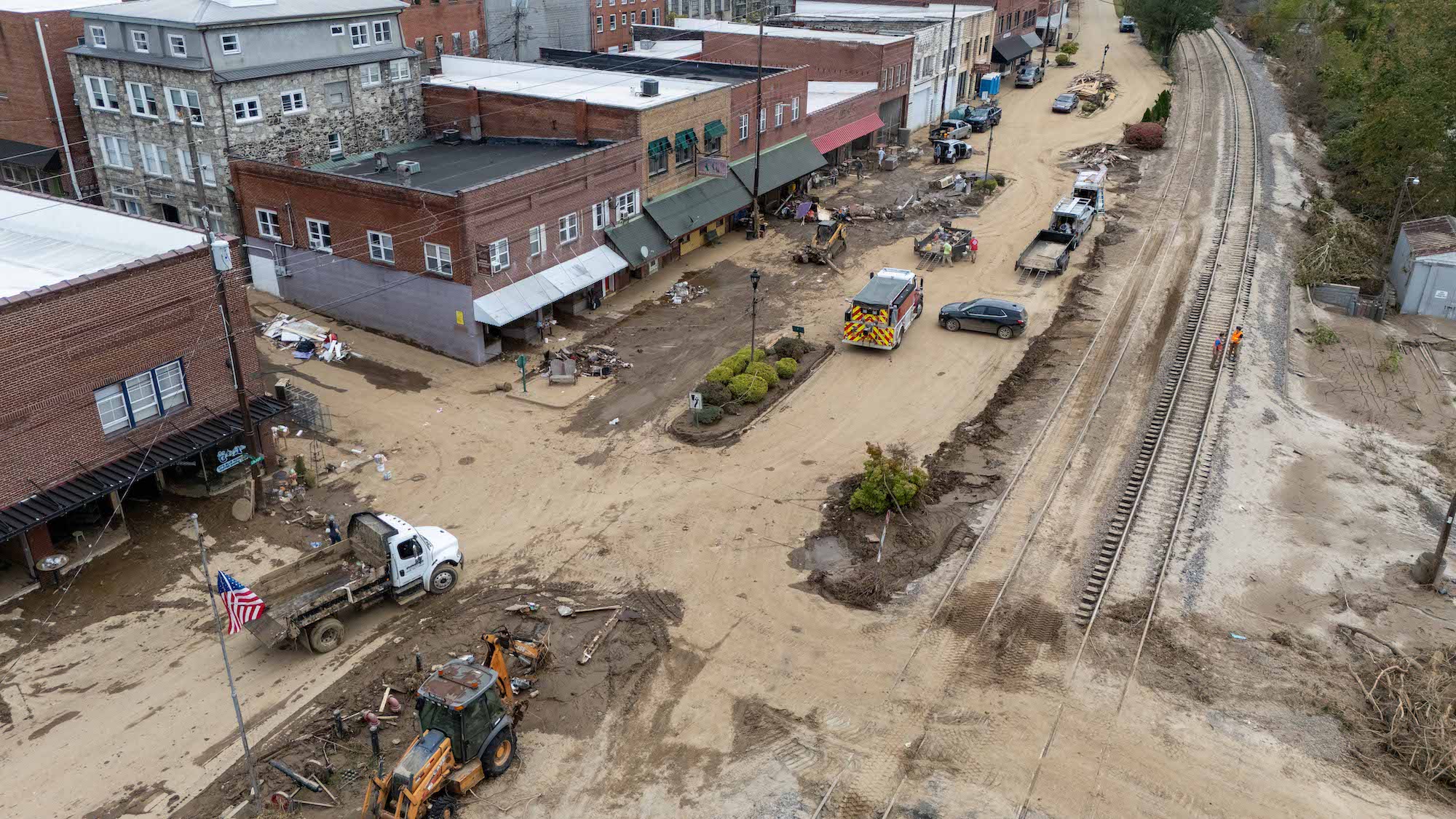Probably the most thrilling a part of the day at Spruce Pine Montessori College is when the truck arrives to empty the porta-johns. At that time within the afternoon, the youngsters abandon their toy dinosaurs and monkey bars, throw up their palms, and yell in pleasure as they run to look at the truck do its work. It’s fortunate that they discover one thing to be so joyful about, Principal Jennifer Rambo mentioned on a latest sunny afternoon, as a result of issues have been a multitude for the previous seven weeks.
The flooding that devastated western North Carolina throughout Hurricane Helene laid waste to communities throughout the area, spitting up nice torrents of mud and washing away properties, automobiles, and other people. The panorama alongside the creeks and mountainsides has been endlessly modified.
Past the fallen timber, sliding hillsides, and broken buildings, Helene took out crucial infrastructure, like web and electrical energy, water, and sewer. Everybody would have appreciated extra time to get issues so as, however working households had been determined for childcare and the need to renew courses was too nice. “We needed to get open,” Rambo mentioned. “The children wanted some routine and construction and consistency, and households wanted to return to work.”
Though people in Spruce Pine had been advised Thursday they might lastly cease boiling water earlier than utilizing it, the varsity nonetheless can’t flush its bathrooms as a result of the sewers stay a multitude. Along with two moveable bathrooms (and particular seats so the smaller kids wouldn’t fall in), it has had to purchase water by the barrel and spend $600 to put in moveable hand-washing sinks. The payments proceed including up: $360 per week for the johns and $350 each time they want emptying. Everybody has needed to alter to those modifications and extra, at the same time as they’ve handled comparable issues at residence.

It’s been that approach in every single place. The storm killed 103 folks all through western North Carolina and surrounding areas. Many extra had been injured. All advised, the wind and the water broken as many as 126,000 properties, and dozens of roads and bridges merely washed away.
Helene additionally decimated greater than two dozen water utilities. For weeks after the storm, folks needed to boil something that wasn’t poured from a bottle, and plenty of of them drew from creeks and ponds simply to flush their bathrooms. People in Asheville, the place faucets ran dry for 3 weeks, had been advised simply this week that their water is protected to drink with out boiling it first, however 1000’s of individuals served by 16 utilities nonetheless take care of sketchy water, low strain, and different frustrations. In an effort to make their lives a little bit simpler, officers dipped right into a $273 million reduction package deal to dot this finish of North Carolina with 650 moveable bathrooms and 15 “neighborhood care stations” with showers and washing machines.
Asheville was fortunate sufficient to have upgraded its reservoir final yr, one thing that prevented even worse flooding and allowed the area’s largest metropolis and the communities that rely on it for water to get well before they in any other case might need. However for cities like Spruce Pine, the monetary and engineering challenges of repairing their water programs are as formidable because the hurricane that broke them.

Steve Exum / Getty Photos
The water that flows into the North Fork Reservoir, which serves Asheville and the cities of Black Mountain and Swannanoa, at all times ran clear and clear from its headwaters excessive in Pisgah Nationwide Forest. However mud and particles have turned it murky brown and broken a lot of the gear wanted to pump it. Crews have labored across the clock to set issues proper, reconnecting pipelines in report time and drawing muck from the lake.
Repairing municipal water programs leveled by a storm that washed away distribution traces, overwhelmed intakes, and inundated therapy crops is not any simple feat. The problem is acute in mountain communities, the place geography is a problem. A lot of the infrastructure required to attract, deal with, and distribute water usually sits alongside reservoirs, inserting them squarely in a floodplain when the torrent arrives and growing the chance of injury. Reaching something needing consideration can take days and even weeks as a result of the traces that carry water to clients meander by means of valleys, over ridgelines, and alongside roadways, a lot of which stay impassable. Spruce Pine Water & Sewer has restored service to 90 % of its 2,000 or so clients, however can’t do a lot for the remainder of them till the roads are fastened.
The sewer system stays a multitude too. City supervisor Darlene Butler has requested residents to preserve water as she works with county officers and the Federal Emergency Administration Company to erect a brief therapy facility. The gear is just now arriving and can, at greatest, be a Band-Help for a multi-year repair. “We had numerous harm there, so we’re attempting to encourage folks to not use numerous water and put it into our sewer system,” she mentioned.

Plenty of these utilities struggled even earlier than Helene. In lots of Appalachian cities, the businesses that after paid to keep up water and sewer programs have shut down or moved on, and shrinking populations generate much less income to maintain issues shiny and new. That is endemic all through Appalachia. Residents in McDowell County, West Virginia — the place one-third of households reside in poverty — have for instance given up on the customarily discolored water that flows from their faucets and purchase it by the case as a substitute. Pipes in Martin County, Kentucky lose about 64 % of what flows by means of them, an issue that began 24 years in the past when a poisonous coal slurry spill broken them. The burden of those failures falls on clients who should adapt to the state of affairs at the same time as their charges climb. (Charges in Martin County, North Carolina, to supply one instance, are among the many nation’s highest.)
But different programs, notably these in vacationer cities, wrestle to maintain up with quickly rising populations. The challenges are compounded by the problem of operating new traces within the mountains and sustaining the complicated pumps wanted to keep up strain over ridgelines. “It is a actually, actually excellent place to reside,” mentioned Clay Chandler, Asheville’s water sources info officer. “It’s lovely. The individuals are superb. However, man, it makes it onerous to function a water system.”

Steve Exum / Getty Photos
Spruce Pine’s system is so previous that Butler has no concept when its pipes had been laid, although she guesses it was 60 years in the past. The pump station, lately upgraded with cash from the American Rescue Plan, was in-built 1967. It has seen overhauls as issues broke, however rural utilities hardly ever make wholesale enhancements as a result of they’re costly and disruptive. “I believe, like most small cities, we’ve struggled for the funds to be proactive as a substitute of reactive,” Butler mentioned.
At the same time as communities take care of the aftermath of a lot deferred upkeep, others are dealing with the inescapable proven fact that rebuilding on a floodplain could not make sense. Spruce Pine is banking on hazard mitigation funding from FEMA and assist from federal officers to maneuver its wastewater therapy plant to increased floor.
The work wanted to completely, and completely, restore water and sewer service in these communities will by most estimates take two to 4 years and value many thousands and thousands of {dollars}. In the meantime, crews proceed taking part in whack-a-mole as getting older traces break. One other one gave approach in rural Yancey County final week, sending a geyser dozens of toes into the air.
About 2,000 folks reside in Spruce Pine, a busy place with water-intensive companies which have been impacted by the disruption. There’s the mine that produces a number of the purest quartz on the earth and despatched heavy gear to assist restore service. There are the eating places and kitschy points of interest that drive a burgeoning tourism trade. After which there are the 2 state prisons, every of which holds about 800 folks (who had been relocated after spending per week in flooded cells) and, like prisons in every single place, burden the native water and sewer programs.
The continued disaster additionally has made offering fundamental providers a problem. Blue Ridge Regional Hospital, which serves three counties, has lengthy had a standby energy provide however scrambled to deal with shedding water. Vehicles haul in what’s wanted, and large bladders accumulate what’s been used. “We had backup turbines to produce the hospital in case of an emergency,” mentioned Alex Glover, chair of the hospital’s board of administrators. “However we by no means dreamed we might lose water and sewage capabilities, and we misplaced them all of sudden.”
With water in brief provide, the volunteer fireplace division banned burning the yard waste, brush, and different particles folks have been clearing for weeks. “If we had an enormous fireplace and we would have liked to take a number of thousand gallons or extra out of the system, we don’t actually know for positive how lengthy that provide would maintain up,” mentioned firefighter Chris Westveer.

Katie Myers / Grist / Blue Ridge Public Radio
The division has skilled some shut calls. Westveer recalled one horrifying evening when wiring in a broken residence sparked a hearth. The street had been washed away, forcing crews to strategy on an all-terrain car. With no water on faucet, they drew what they wanted from a river and hoped the wind wouldn’t unfold the flames past their capability to struggle them.
Such strains on public providers, already scarce all through mountain communities, compound the stress felt by those that have gone practically two months with out dependable water. Individuals in Banner Elk, a neighborhood of 1,000 or in order that needed to rebuild a street earlier than it might restore water and sewer traces, couldn’t flush their bathrooms for a month. County officers apprehensive that the uncooked sewage would movement into the Elk River. Meredith Olan, director of the Banner Home historical past museum, has been hauling water from the creek and boiling it simply to do the dishes. “I’m very adept at carrying buckets now,” she mentioned ruefully. Anybody eager to take a bathe needed to rely on the goodwill of pals with wells to attract from. However even that was no assure. Some had been inundated with floodwaters and might need been contaminated with E. coli and different pathogens, and the electrical pumps that pull water from the depths aren’t any good when the ability is out.

At the same time as these communities work nonstop to revive service, native and state officers are waiting for the following huge storm. Members of the state Water Infrastructure Authority, a physique tasked with monetary planning for the state’s water and sewer utilities, gathered final month to ponder updates to North Carolina’s water infrastructure grasp plan. The doc, created in 2017, explored methods of guaranteeing the monetary stability of water utilities. Members of the panel, which incorporates a number of utility administrators, a water engineer, and the top of the state Division of Water Infrastructure, acknowledged that native officers usually have little concept how water and wastewater work and need assistance navigating the aftermath of a catastrophe and making use of for grants to get well from it.
Specialists on the topic mentioned consolidating the area’s patchwork of small programs could be the key to rebuilding and sustaining them. Some are doing simply that. 4 counties in southwestern Virginia are working collectively to put in dozens of miles of water traces. Such efforts are simpler amongst cities which are shut collectively, like Mars Hill and Weaverville. These small cities, that are quickly turning into suburbs of Asheville, have linked their water programs to allow them to guarantee there’s sufficient to produce new housing. That connection allowed Weaverville to rapidly purchase and transfer water when the flood knocked out its municipal system. The same association proposed for close by Marshall would price about $15 million.

Teamwork can present a backup provide of water, cut back upkeep prices, and permit small utilities to share these important sources and collaborate on, fairly than compete for, grant purposes. Such efforts will develop more and more necessary as growth and a warming world additional burden these programs. “I believe the fiefdom of water provide has to alter for everybody to thrive in an period of local weather disaster,” mentioned Will Harlan, the Southeast director of the Heart for Organic Range and a resident of Barnardsville, one other neighborhood not removed from Asheville.
Even when a bodily collaboration isn’t attainable, an organizational one is perhaps. “In case you’ve bought three tiny cities and no one can afford to rent a public works or public utilities director, the three of y’all go in collectively and rent a professional utilities director,” one member of the grasp plan committee mentioned throughout a public convention name.

Barring any modifications, the area is susceptible to merely rebuilding what it has, solely to look at all of it wash away within the subsequent huge flood, mentioned Francis de los Reyes. He’s an engineering professor at North Carolina State College who focuses on sanitation programs. He’d wish to see communities transfer their water infrastructure to increased floor, as Spruce Pine is doing, and relocate flood-prone neighborhoods, as is occurring in jap Kentucky. “Your decisions are mitigation, adaptation, or staying in fight-or-flight,” de los Reyes mentioned.
However it takes greater than a collaborative spirit and expert management to restore a water system and harden it in opposition to future disasters. It requires communities to pool sources or search federal assist as a result of they don’t have the thousands and thousands of {dollars} that work requires. Even earlier than Helene struck, the bipartisan infrastructure regulation put aside $603 million to assist North Carolina exchange previous pipes and different {hardware}. The destiny of that cash stays in query, nevertheless, as a result of President-elect Donald Trump has vowed to undo a lot of the Biden administration’s local weather work.
Again at Spruce Pine Montessori College, Jennifer Rambo is attempting to not let uncertainty concerning the future get to her. It’s onerous sufficient coping with the current. Past the weeks with out potable water, she is grappling with spotty web entry and electrical energy, and an inescapable sense of loss. Within the days after Helene, she spent a lot of her time attempting to find out if folks had been nonetheless alive. Her voice wavered as she mentioned kind of the identical phrases that so many in her neighborhood, and others prefer it, have echoed over the previous two months: “No one was ready.”





